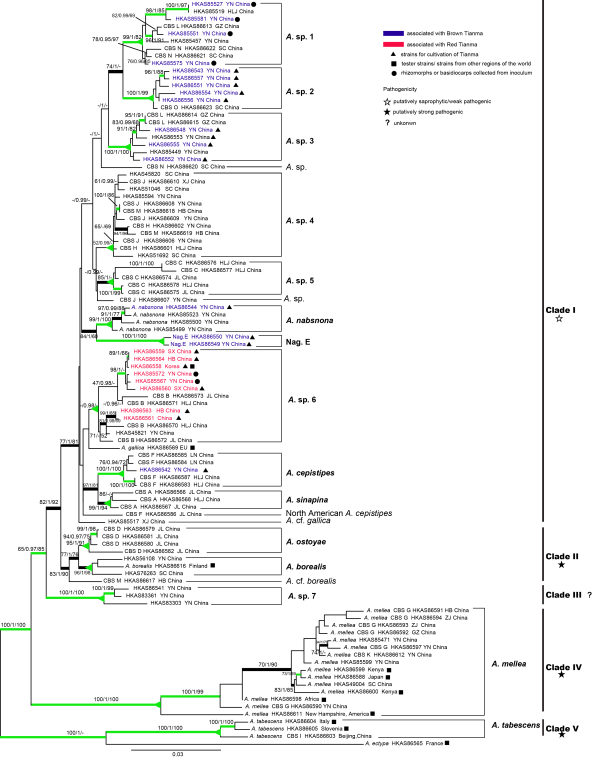PLoS ONE:中科院昆明植物所杨祝良研究组发表蜜环菌物种多样性及
近日,国际知名学术期刊《PLOS ONE》在线发表了中国科学院昆明植物研究所东亚植物多样性与生物地理学重点实验室杨祝良研究组的一篇研究论文,研究发现了蜜环菌物种多样性及天麻共生菌研究进展。
蜜环菌属(Armillaria)隶属于膨瑚菌科(PhysalacriAceae),是一个世界性分布的属,全球报道约有50余种,中国已报道了7种。该属真菌既是重要的林木病原菌,也是重要的食用菌,还是名贵中药天麻的共生菌。该属真菌形态特征寡少并易受环境条件影响而变化,较难用形态分类方法或菌株交配的生物种方法进行物种识别。开展蜜环菌属分子系统发育研究,对于揭示我国蜜环菌属物种的多样性、认识与天麻共生的蜜环菌专一性物种具有重要的理论意义和应用价值。
杨祝良研究组通过近几年来的野外考察积累及与国内同行合作,获得了东亚、中非、欧洲和北美的材料,由博士生郭婷通过多基因片段测序,选取了91号中国蜜环菌代表性样品,基于三个基因片段(ITS、tef1-α和β-tubulin)的核苷酸序列,对蜜环菌进行了研究,结果表明:1)中国蜜环菌至少有15个系统发育分支,包括了7个新支系(Lineages 1-7)和两个新记录(Nag. E和九妹蜜环菌A. nabsnona),新支系中有6个为中国特有;2)清晰地解析了14个生物种之间的系统亲缘关系,发现蜜环菌生物种与系统种之间并非完全一一对应,仅有6个生物种的菌株与系统发育种一一对应,其余生物种的菌株或分属于两个不同的系统发育种或两个或多个不同生物种的菌株归属于同一个系统发育种;3)与天麻共生的蜜环菌共有7种(粗柄蜜环菌A. cepistipes、九妹蜜环菌、Nag. E、Lineages 1-3和Lineages 6),它们均位于同一分支,具有较近的亲缘关系,并提出应采取“适地适菌”和“适麻适菌”的原则,选择低致病的蜜环菌菌种,Lineages 2和Lineages 3的菌种适合于栽培乌天麻,而Lineages 6的菌株适合于栽培红天麻。该研究对于解决蜜环菌属的系统分类问题、揭示该属真菌的物种多样性及指导天麻栽培的菌种选育具有较重要的科学意义。

基于三个基因片段构建的蜜环菌属(Armillaria)系统发育树
原文链接:
Phylogenetic Analyses of Armillaria Reveal at Least 15 Phylogenetic Lineages in China, Seven of Which Are Associated with Cultivated Gastrodia elata
原文摘要:
Fungal species of Armillaria, which can act as plant pathogens and/or symbionts of the Chinese traditional medicinal herb Gastrodia elata (“Tianma”), are ecologically and economically important and have consequently attracted the attention of mycologists. However, their taxonomy has been highly dependent on morphological characterization and mating tests. In this study, we phylogenetically analyzed Chinese Armillaria samples using the sequences of the internal transcribed spacer region, translation elongation factor-1 alpha gene and beta-tubulin gene. Our data revealed at least 15 phylogenetic lineages of Armillaria from China, of which seven were newly discovered and two were recorded from China for the first time. Fourteen Chinese BioLogical species of Armillaria, which were previously defined based on mating tests, could be assigned to the 15 phylogenetic lineages identified herein. Seven of the 15 phylogenetic lineages were found to be disjunctively distributed in different continents of the Northern Hemisphere, while eight were revealed to be endemic to certain continents. In addition, we found that seven phylogenetic lineages of Armillaria were used for the cultivation of Tianma, only two of which had been recorded to be associated with Tianma previously. We also illustrated that G. elata f. glauca (“Brown Tianma”) and G. elata f. elata (“Red Tianma”), two cultivars of Tianma grown in different regions of China, form symbiotic relationships with different phylogenetic lineages of Armillaria. These findings should aid the development of Tianma cultivation in China.
doi:10.1371/journal.pone.0154794
作者:杨祝良

